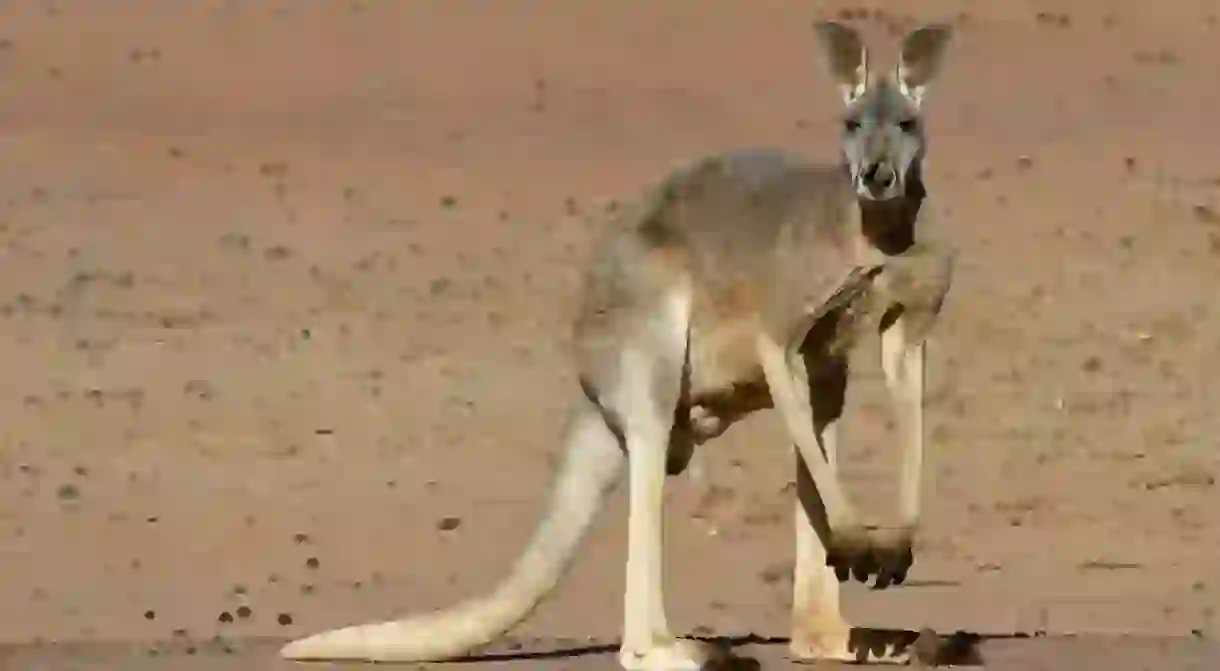Red Kangaroo: 11 Facts About Australia's National Animal

People from every corner of the globe travel to Australia to meet a kangaroo — the adorable, exotic and uniquely Australian animal that hops all over this sunburnt continent. Read on for 11 things you might not have known about the red kangaroo.
The red kangaroo is the largest kangaroo species
There are four main species of kangaroo: the red kangaroo, the eastern grey kangaroo, the western grey kangaroo and the antilopine kangaroo. Red kangaroos are the biggest of the bunch, growing up to two metres in height and 90 kilogrammes in weight. Eastern greys make up the biggest chunk of Australia’s enormous kangaroo population (roughly 50 million), but red kangaroos, common across the arid inland, are the official national animal.

They’re significant to Indigenous Australians
Australia’s First Peoples hunted kangaroos for thousands of years for both their skin and their meat, and the name itself derives from an Indigenous language. The roo plays a part in different Dreaming stories, and its social and cultural significance to Indigenous people has been a bone of contention in recent debates over kangaroo harvesting.
The kangaroo is one of the earliest symbols of Australia
The British colonists of the late 18th Century were fascinated by this exotic animal, which was first recorded as a kanguru by Botanist Joseph Banks in 1770. They were described as having the head of a deer (minus the antlers) and the hop of a frog. After illustrations captivated European audiences, they soon became a symbol of this faraway Australian continent.

They’ve remained the country’s most iconic emblem
Over the last two centuries, the kangaroo has become an unambiguous emblem of Australia, and easily its most enduring symbol. The roo appears on the Australian Coat of Arms, the tails of Qantas planes, Tourism Australia’s logo, various insignia of the Australian Defence Force, coins, stamps… the list goes on.
Their pouch isn’t like a pocket
Female red kangaroos — which, despite their name, are actually grey in colour — protect their joeys in a pouch, a fold of skin that covers the nipples. But in the eternal words of Bart Simpson, “It’s not like in cartoons.” Kangaroo pouches aren’t some pocket attached to the mother’s stomach like the shopping basket on the front of a bike — they’re more like a small hole that babies climb into until they’re mature enough to leave.
Their teeth are replaceable
Who knew that kangaroos have so much in common with crocodiles? Like crocs, roos have rows of teeth that fall out, then are continually replaced. This process, known as polyphyodonty, is rare in mammals — elephants and manatees are the only other mammals that sit alongside kangaroos in the replaceable teeth club.
They love to fight
Both male and female red kangaroos box each other to compete for water, and male roos also fight over females. Kangaroos stand high on their hind legs then paw and kick each other, and the image of the ‘Boxing Kangaroo’ has been one of Australia’s most popular sporting symbols for decades, particularly since the historic America’s Cup sailing triumph in 1983.

They’re a serious traffic hazard
Almost everyone who’s driven through the outback has seen kangaroo warning signs, because roos are so common (and dangerous) on Australian roads. A 90 kilogramme kangaroo hopping at 50km/h can cause some serious damage to a car flying along the open road; ‘roo bars’ are a popular protection installed to shield vehicles. Kanga collisions are particularly common at dawn and dusk.
Australians have been told to eat more of them
It might sound like treason to eat your national emblem, but several experts have encouraged Australians to chow down on Skippy for the sake of the environment. Roos emit less methane than cows, and harvesting their out-of-control numbers helps preserve the natural ecosystem. You can try kangaroo steak, sausages and pizza if you’re up for it.

Kangaroos have inspired dozens of place names
There’s a Kangaroo Island in South Australia (SA), Queensland, Tasmania and Western Australia, a Kangaroo Flat in Victoria and SA, a Kangaroo Point in Queensland and New South Wales (NSW), and even two separate Kangaroo Rivers in NSW. Perhaps the only thing more common than kangaroos themselves are places named after them.
They’re the mascot of a Czech football club
It’s easy to understand why Australia’s national football (Socceroos) and rugby league (Kangaroos) teams are named after the country’s animal emblem. But how on earth did a Czech football team end up with a kangaroo on their shirts? Bohemians Praha 1905 use a kangaroo as their crest, following a 1927 tour of Australia, when they were awarded two roos they donated to the Prague Zoo.














